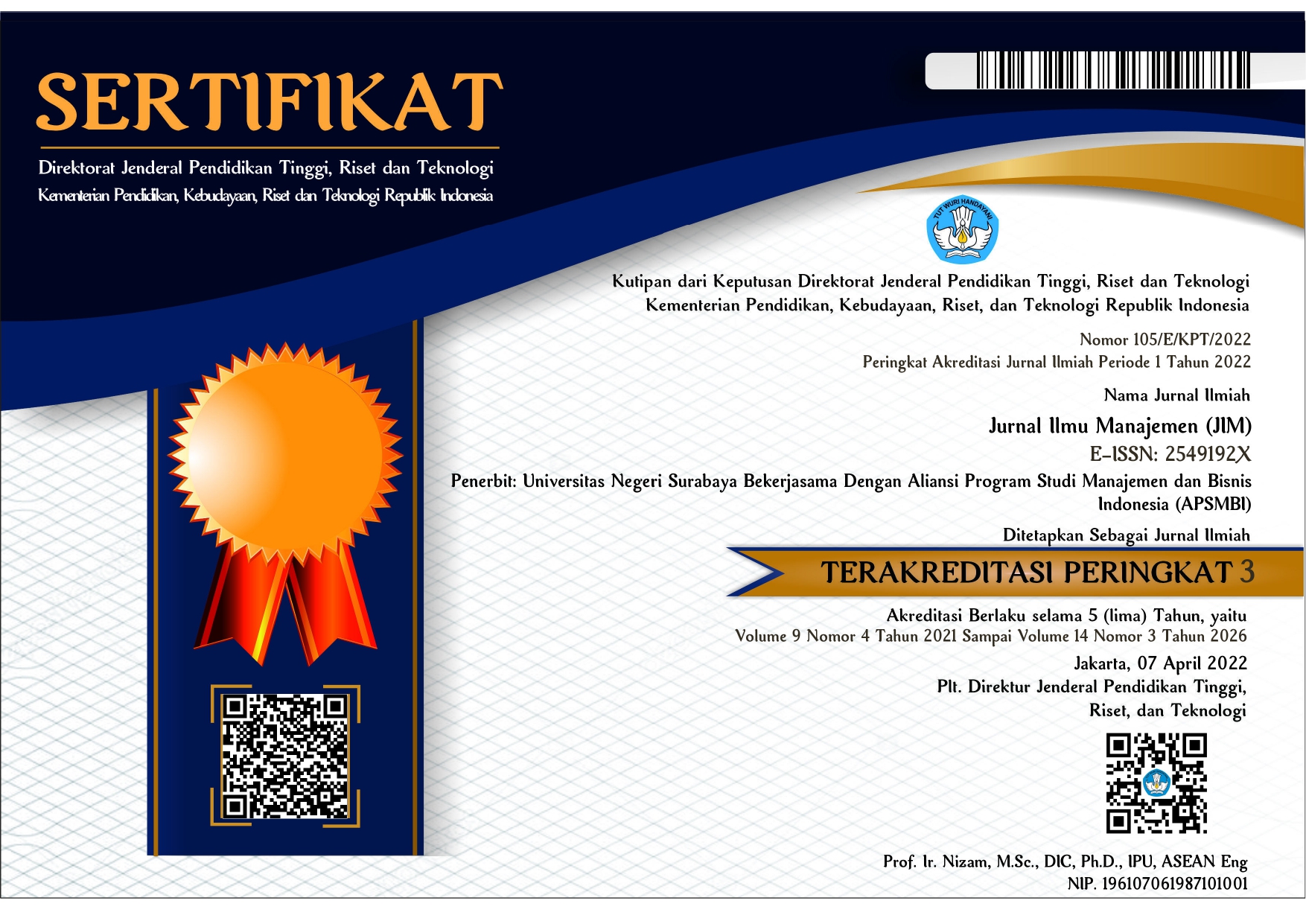Pengaruh Lingkungan Kerja Fisik dan Lingkungan Kerja Nonfisik terhadap Turnover Intention dengan Kepuasan Kerja sebagai Variabel Intervening
DOI:
https://doi.org/10.26740/jim.v10n2.p394-407Keywords:
job satisfaction, non-physical work environment, physical work environment, turnover intentionAbstract
This study examines the relationship between the physical and non-physical work environments on turnover intention through job satisfaction as an intervening variable. The data is collected using convenience sampling. The total respondents obtained are 41 employees from a company by distributing offline questionnaires. This research is a quantitative approach to causality analysis using Structural Equation Modelling (SEM) analysis technique in SmartPLS software version 3.0. This study shows that the physical work environment does not affect employee job satisfaction and turnover intention. The non-physical work environment has a significant positive effect on job satisfaction. The non-physical work environment has a significant negative effect on turnover intention. And Job satisfaction has a significant negative effect on turnover intention. This research implies that the company is conducting training on internalising company values. The company leaders could better provide direction to subordinates at work and offer promotion opportunities for employees with high work performance. To increase job satisfaction and reduce turnover intention, companies can also improve the non-physical work environment by implementing employee policies that do not harm the company and its employees, e.g., continuing to provide WFH employees' salaries.
References
Afandi, P. (2018). Manajemen Sumber Daya Manusia (Teori, Konsep, dan Indikator). Riau : Zanafa Publishing.
Colquitt, J. A., Lepine, J. A., & Wesson, M. J. (2019). Organizational Behavior Improving Performance and Commitment in the Workplace. New York : McGraw Hill.
Flippo, E. B. (1994). Karir dalam Organisasi. Semarang : BPFE Universitas Diponegoro.
Ghozali, I. (2014). Structural Equation Modeling, Metode Alternatif dengan Partial Least Square (PLS). Semarang : Badan Penerbit Universitas Diponegoro.
Mangkunegara, A.P. (2013). Manajemen Sumber daya manusia Perusahaan. Bandung : Remaja Rosdakarya.
Mathis, R. L., & Jackson, J. H. (2003). Human Resource Management. New Jersey : Prentice Hall.
Mobley, W. H. (1986). Pergantian Karyawan : Sebab, Akibat dan Pengendaliannya (N. Imam (ed.)). Jakarta : PT Pustaka Binaman Pressindo.
Nitisemito, A. S. (2002). Manajemen Personalia. Jakarta : Ghalia Indonesia.
Pramitha, G. D., Supartha, I. W. G., & Riana, I. G. (2012). Pengaruh Kepuasan Kerja Terhadap Komitmen Organisasional dan Kinerja Karyawan Koperasi Krama Bali. E-Jurnal Manajemen Universitas Udayana, 1(2), 191-207.
Robbins, S. P., & Judge, T. A. (2013). Organizational Behavior (Edition 15). New Jersey : Pearson Education.
Sedarmayanti. (2017). Sumber Daya Manusia dan Produktivitas Kerja. Bandung : Mandar Maju.
Susanto, E. ., & Gunawan, C. (2013). Kepuasan Kerja, Komitmen Organisasional, dan Turnover Intention. Jurnal Mitra Ekonomi Dan Manajemen Bisnis, 4(1), 76-88.
Sutrisno, E. (2009). Manajemen Sumber Daya Manusia (Edisi 1). Jakarta : Kencana Prenada Media Group.
Wursanto. (2009). Dasar-Dasar Ilmu Organisasi. Yogyakarta : Andi.
Downloads
Published
How to Cite
Issue
Section
License

This work is licensed under a Creative Commons Attribution-NonCommercial 4.0 International License.
 Abstract views: 2105
,
Abstract views: 2105
, PDF Downloads: 2083
PDF Downloads: 2083










